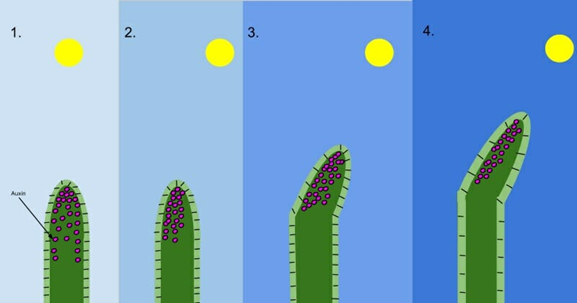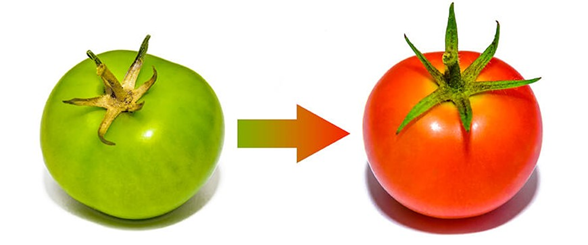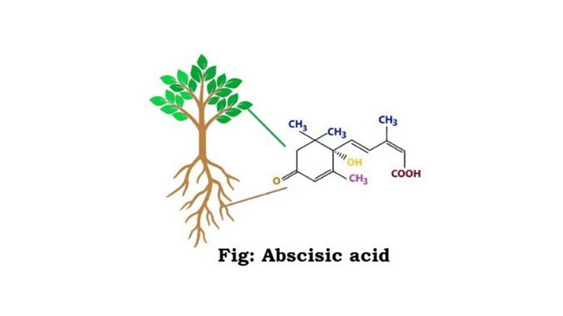1. AUXINS
Auxins were first discovered from human urine. It is a plant growth promoter. They are generally produced at the tip of the stems and roots and are sent to various of plants for their action. The natural axon's are named as Indole-3-Acetic Acid[IAA] and Indole-Butyric acid[IBA]. The synthetic auxins are named as Naphthalene acetic acid[NAA] and 2-4-D[2,4-dinitrophenoxyacetic acid]. Natural auxins are obtained from plants. All the auxins are used in agriculture and horticulture. This is used widely for plant propagation as it initiates roots on cutting the stem. They prevent falling of fruits and leaves in the early stages of plant but it promotes abscission in the older plants. Removing the tip of shoot [Decapitation], results in the growth of lateral buds. Decapitation is widely used in tea plantations. Auxin also help in flowering in some plants like pineapple plant. The tip of the plant moves towards the direction of sunlight. Auxin help in the growth of tomatoes without any fertilization. 2-4-D (a synthetic auxin) is used to kill dicotyledonous weeds and it will not cause any harm to monocotyledonous seeds. Auxins also help in cell division.

2. GIBBERELLINS
Gibberellin is the homone which is a plant growth promoter. 100 gibberellins are obtained from fungi and higher plants. GA3 was the first one to be discovered and was very helpful for many studies. All the hormones are acidic in nature. They help in the rapid growth of length of the shoot axis. The rapid increase in the length of the shoot is termed as bolting. For example it increases the length of the stock of the grapes. Gibberellins help in giving a shape and help in developing of fruit like apple. When they are applied to any plant they delay the fall of fruits and leaves, also called senescence. They also help in some industries like brewing industries as they help in speeding up the process of malting. Sugarcane crops have stems which store carbohydrates as sugars and the amount of sugar increases when we apply gibberellins to sugracane stem.It increases the sugar amount up to 15-20 tones. This hormone helps in early seeding that means it hastens the maturity period in the young plants. Bolting is a process increase in internode which is promoted by this hormone in beet, cabbage and rosette plants.
3. CYTOKININS
Cytokinins are also the hormones which are plant growth promoters. This was first discovered from kinetin which is an adenine derivative.. Kinetin was obtained from herring sperm DNA. This kinetin is a synthetic cytokinin. Natural cytokinin is obtained from corn kernels and coconut milk known as Zeatin. These zeatin have lead to the discovery of many natural cytokinins which helped in promoting the growth of plant. They helped in rapid cell division. They helped in producing new leaves and also plenty amout of chlorophyll is present in the leaves which help in absorbing sunlight and cause photosynthesis. They delay senescence of leaves as they promote nutrient metabolism They act antagonistic to auxin that is they help in overcome of apical dominance but auxin promote apical dominance. Hence they are antagonistic to each other.
4. ETHYLENE
Ethylene is a hormone which can be called as both plant growth promoter as well as inhibitor but mostly it has the function of inhibition. Ethylene is the only gaseous hormone in plants. This hormone is mostly found in the tissues which are undergoing senescence and abscission. Ethylene helps in horizontal growth of seeds. It helps is making the axis fat and hook is formed on the apical bud of dicot seeds. Ethylene promotes ripening and falling off of leaves as well as fruits. It promotes the rate of respiration during ripening as it promotes ripening and increase in respiration rate is respiratory climate. Ethylene helps the seed to sprout out of the soil and germinate out their bud as in potato. So they are antagonistic to abscisic acid which is the fifth hormone. They help in the rapid growth of length of the petiole in the deep water rice plant. It helps to grow the shoots above the water. This hormone promotes root hair and growth Thus it helps the plants to absorb more water .It is used for simultaneous growth of fruit and flower in plants like pineapple. It induces flowering in mango. This hormone is more used in agriculture and commonly known as Etephon. It is soluble in water and releases the hormone ethylene slowly. This hormone hastens fruit ripening so they are synergistic to Gibberellins. They promote falling of leaves and fruits rapidly in plants like cherry, wallnut, cotton. It helps in rapid growth of gynoecium in cucumber.

5. ABSCISIC ACID
Abscisic acid is a hormone which is derived from carotene's. This hormone is a plant growth inhibitor. This is discovered from a ripened banana. This hormone is to cause falling of leaves rapidly and stop the seed germination. But it some how helps the plant to grow and develop. As mentioned before, This is a plant growth inhibitor so it stops the metabolism of plant. it doesn't allow seed germination. It have a certain benefits like it helps to close the stomata of leaves in an unfavourable conditions and helps the plant to save water. So this hormone is called stress hormone. It help in seed development and plant growth as it induces seed dormancy so that the seed it covered by soil under ground and can escape the harsh climatic conditions. This hormone acts antagonistic to Gibberellins as they break the seed dormancy.



You must be logged in to post a comment.